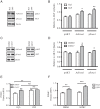Nitric Oxide Exerts Basal and Insulin-Dependent Anorexigenic Actions in POMC Hypothalamic Neurons
- PMID: 26930171
- PMCID: PMC5414647
- DOI: 10.1210/me.2015-1275
Nitric Oxide Exerts Basal and Insulin-Dependent Anorexigenic Actions in POMC Hypothalamic Neurons
Abstract
The arcuate nucleus of the hypothalamus represents a key center for the control of appetite and feeding through the regulation of 2 key neuronal populations, notably agouti-related peptide/neuropeptide Y and proopimelanocortin (POMC)/cocaine- and amphetamine-regulated transcript neurons. Altered regulation of these neuronal networks, in particular the dysfunction of POMC neurons upon high-fat consumption, is a major pathogenic mechanism involved in the development of obesity and type 2 diabetes mellitus. Efforts are underway to preserve the integrity or enhance the functionality of POMC neurons in order to prevent or treat these metabolic diseases. Here, we report for the first time that the nitric oxide (NO(-)) donor, sodium nitroprusside (SNP) mediates anorexigenic actions in both hypothalamic tissue and hypothalamic-derived cell models by mediating the up-regulation of POMC levels. SNP increased POMC mRNA in a dose-dependent manner and enhanced α-melanocortin-secreting hormone production and secretion in mHypoA-POMC/GFP-2 cells. SNP also enhanced insulin-driven POMC expression likely by inhibiting the deacetylase activity of sirtuin 1. Furthermore, SNP enhanced insulin-dependent POMC expression, likely by reducing the transcriptional repression of Foxo1 on the POMC gene. Prolonged SNP exposure prevented the development of insulin resistance. Taken together, the NO(-) donor SNP enhances the anorexigenic potential of POMC neurons by promoting its transcriptional expression independent and in cooperation with insulin. Thus, increasing cellular NO(-) levels represents a hormone-independent method of promoting anorexigenic output from the existing POMC neuronal populations and may be advantageous in the fight against these prevalent disorders.
Figures








Similar articles
-
Cellular insulin resistance disrupts hypothalamic mHypoA-POMC/GFP neuronal signaling pathways.J Endocrinol. 2013 Nov 28;220(1):13-24. doi: 10.1530/JOE-13-0334. Print 2014 Jan. J Endocrinol. 2013. PMID: 24134870
-
Epigenomic and metabolic responses of hypothalamic POMC neurons to gestational nicotine exposure in adult offspring.Genome Med. 2016 Sep 8;8(1):93. doi: 10.1186/s13073-016-0348-2. Genome Med. 2016. PMID: 27609221 Free PMC article.
-
Up-regulation of POMC and CART mRNAs by intermittent hypoxia via GATA transcription factors in human neuronal cells.Int J Biochem Cell Biol. 2018 Feb;95:100-107. doi: 10.1016/j.biocel.2017.12.012. Epub 2017 Dec 21. Int J Biochem Cell Biol. 2018. PMID: 29275211
-
The hypothalamic arcuate nucleus and the control of peripheral substrates.Best Pract Res Clin Endocrinol Metab. 2014 Oct;28(5):725-37. doi: 10.1016/j.beem.2014.03.003. Epub 2014 Apr 4. Best Pract Res Clin Endocrinol Metab. 2014. PMID: 25256767 Review.
-
Insulin and leptin excite anorexigenic pro-opiomelanocortin neurones via activation of TRPC5 channels.J Neuroendocrinol. 2018 Feb;30(2):10.1111/jne.12501. doi: 10.1111/jne.12501. J Neuroendocrinol. 2018. PMID: 28675783 Free PMC article. Review.
Cited by
-
GenePANDA-a novel network-based gene prioritizing tool for complex diseases.Sci Rep. 2017 Mar 2;7:43258. doi: 10.1038/srep43258. Sci Rep. 2017. PMID: 28252032 Free PMC article.
-
The Microbiota and the Gut-Brain Axis in Controlling Food Intake and Energy Homeostasis.Int J Mol Sci. 2021 May 29;22(11):5830. doi: 10.3390/ijms22115830. Int J Mol Sci. 2021. PMID: 34072450 Free PMC article. Review.
-
Long Term Osmotic Mini Pump Treatment with Alpha-MSH Improves Myocardial Function in Zucker Diabetic Fatty Rats.Molecules. 2017 Oct 12;22(10):1702. doi: 10.3390/molecules22101702. Molecules. 2017. PMID: 29023410 Free PMC article.
-
Hypothalamic miR-1983 Targets Insulin Receptor β and the Insulin-mediated miR-1983 Increase Is Blocked by Metformin.Endocrinology. 2022 Jan 1;163(1):bqab241. doi: 10.1210/endocr/bqab241. Endocrinology. 2022. PMID: 34919671 Free PMC article.
-
Ghrelin enhances food intake and carbohydrate oxidation in a nitric oxide dependent manner.Gen Comp Endocrinol. 2017 Sep 1;250:9-14. doi: 10.1016/j.ygcen.2017.05.017. Epub 2017 May 26. Gen Comp Endocrinol. 2017. PMID: 28552460 Free PMC article.
References
-
- Belgardt BF, Brüning JC. CNS leptin and insulin action in the control of energy homeostasis. Ann NY Acad Sci. 2010;1212:97–113. - PubMed
-
- Brüning JC, Winnay J, Bonner-Weir S, Taylor SI, Accili D, Kahn CR. Development of a novel polygenic model of NIDDM in mice heterozygous for IR and IRS-1 null alleles. Cell. 1997;88:561–572. - PubMed
Publication types
MeSH terms
Substances
Grants and funding
LinkOut - more resources
Full Text Sources
Other Literature Sources
Medical
Research Materials
Miscellaneous

